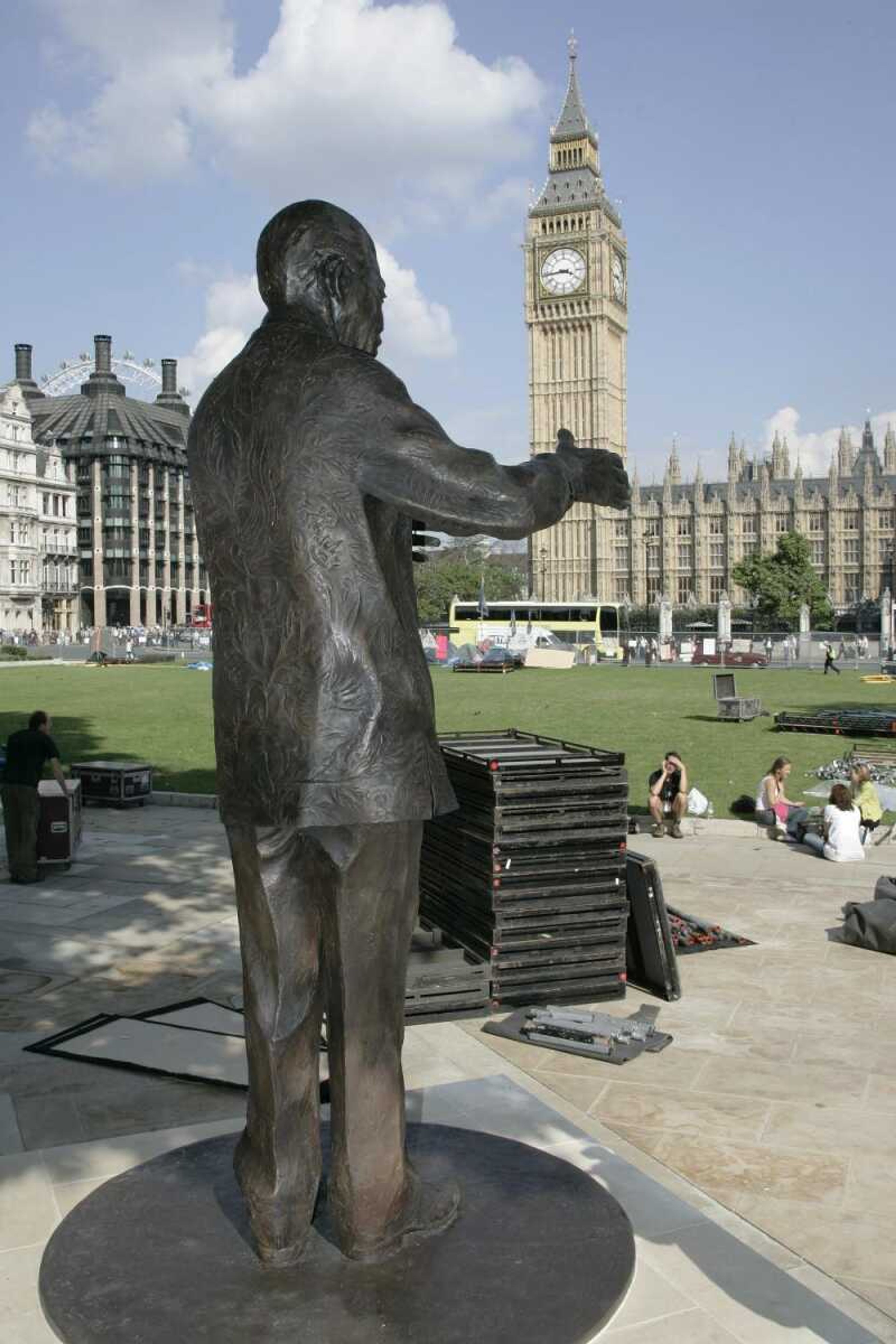Nelson Mandela salutes apartheid resistance at unveiling of statue in his honor
LONDON -- It was 1962 and Nelson Mandela was on the run. Hunted by South African authorities and gearing up for armed struggle against his country's apartheid government, Mandela visited London seeking money, training and support. It was then that he and Oliver Tambo, his partner in the anti-apartheid struggle, walked through Parliament Square surveying the statuary tributes to the British Empire's great and good. The figure of South African statesman Jan Smuts caught their eye...
LONDON -- It was 1962 and Nelson Mandela was on the run. Hunted by South African authorities and gearing up for armed struggle against his country's apartheid government, Mandela visited London seeking money, training and support.
It was then that he and Oliver Tambo, his partner in the anti-apartheid struggle, walked through Parliament Square surveying the statuary tributes to the British Empire's great and good. The figure of South African statesman Jan Smuts caught their eye.
"When we saw the statue of Gen. Smuts near Westminster Abbey, Oliver and I joked that perhaps someday there would be a statue of us in its stead," Mandela wrote in his autobiography, "Long Walk to Freedom."
Forty years later, Mandela returned to the square Wednesday to watch the unveiling of his own statue across from Smuts' -- and join the ranks of Britain's most revered heroes.
"Nelson Mandela is one of the most courageous and best-loved men of all time," Prime Minister Gordon Brown said of the 89-year-old Nobel Peace Prize winner, who has come to personify his country's struggle to end apartheid.
Brown said it was fitting that Mandela, whom he called "the great liberator," joined statues of Abraham Lincoln and Winston Churchill in the square.
Not always a hero
But Mandela was not always considered a hero. Britain maintained close ties with South Africa through the apartheid era, helping to insulate the former colony's government from international isolation at the United Nations. British Prime Minister Margaret Thatcher referred to Mandela's African National Congress as a terrorist organization.
"Even when my friend Gordon, the prime minister, was paying very warm tribute to him, it was not always thus," British lawmaker Nigel Griffiths said, explaining that many British politicians criticized Mandela's decision to take up arms against the white minority regime.
"It's amazing how people have forgotten how they opposed him," Griffiths said.
But Mandela's cause caught the popular imagination, and Britons were among the most committed foes of apartheid internationally. Boycotts were organized of companies doing business in South Africa, and a constant vigil was held in Trafalgar Square as Mandela languished in jail.
Mandela's career as South Africa's first post-apartheid president, which saw the painful -- but largely peaceful -- transition from a white supremacist state to a multiracial democracy, won most of his opponents over. Conservative leader David Cameron said last year that Thatcher had been wrong to label the ANC a terrorist organization, calling Mandela "one of the greatest men alive."
Nevertheless, the effort to erect a statue to Mandela in London was not without controversy.
London Mayor Ken Livingstone campaigned for the Mandela sculpture to be placed in Trafalgar Square -- home to three statues of British military heroes and King George IV. But Westminster Council's planning committee, which had the final say, decided on Parliament Square, saying it was a more suitable location.
In the end, though, the towering bronze statue of Mandela, its polished brown hands stretching toward London's Houses of Parliament, was more than his British supporters had hoped for.
"I never even thought we would live to see Mandela freed from prison -- much less this," said Eddie Fennings, a 43-year-old energy broker, as the crowd around him broke into South African anthems.
Ola Onanuga, 44, said she had protested and marched as Mandela languished in jail. Now she said she was bringing her daughter to the square to give the child a glimpse at what she called a "one of a kind" politician.
"He's someone that our generation and the younger generation will never again see," Onanuga said.
Mandela appeared frail as he made his way Wednesday to the platform, leaning on the arm of his wife, Graca Machel. But he spoke clearly as he invited the crowd to celebrate his 90th birthday next year at a concert in London's Hyde Park in support of his efforts to combat AIDS.
The concert will support his foundation, which is called "46664" -- the number he wore in prison.
The Nobel laureate recalled the time he and Tambo toured the square, looking ambivalently at the symbols of British power.
"The history of the struggle in South Africa is rich with the stories of heroes and heroines, some of them leaders, some of them followers. All of them deserve to be remembered," Mandela said.
"Oliver would have been proud today if he were here."
Connect with the Southeast Missourian Newsroom:
For corrections to this story or other insights for the editor, click here. To submit a letter to the editor, click here. To learn about the Southeast Missourian’s AI Policy, click here.








